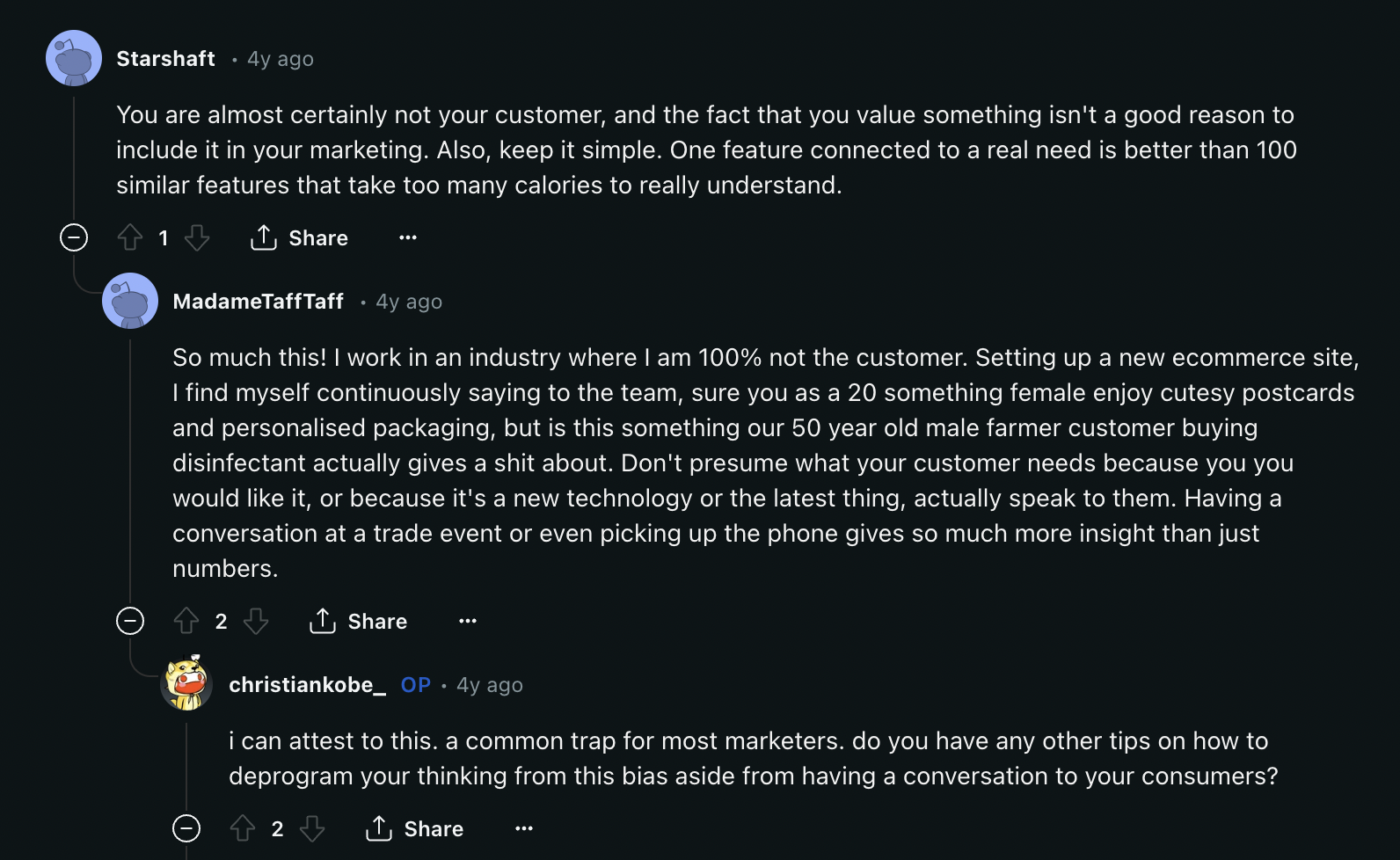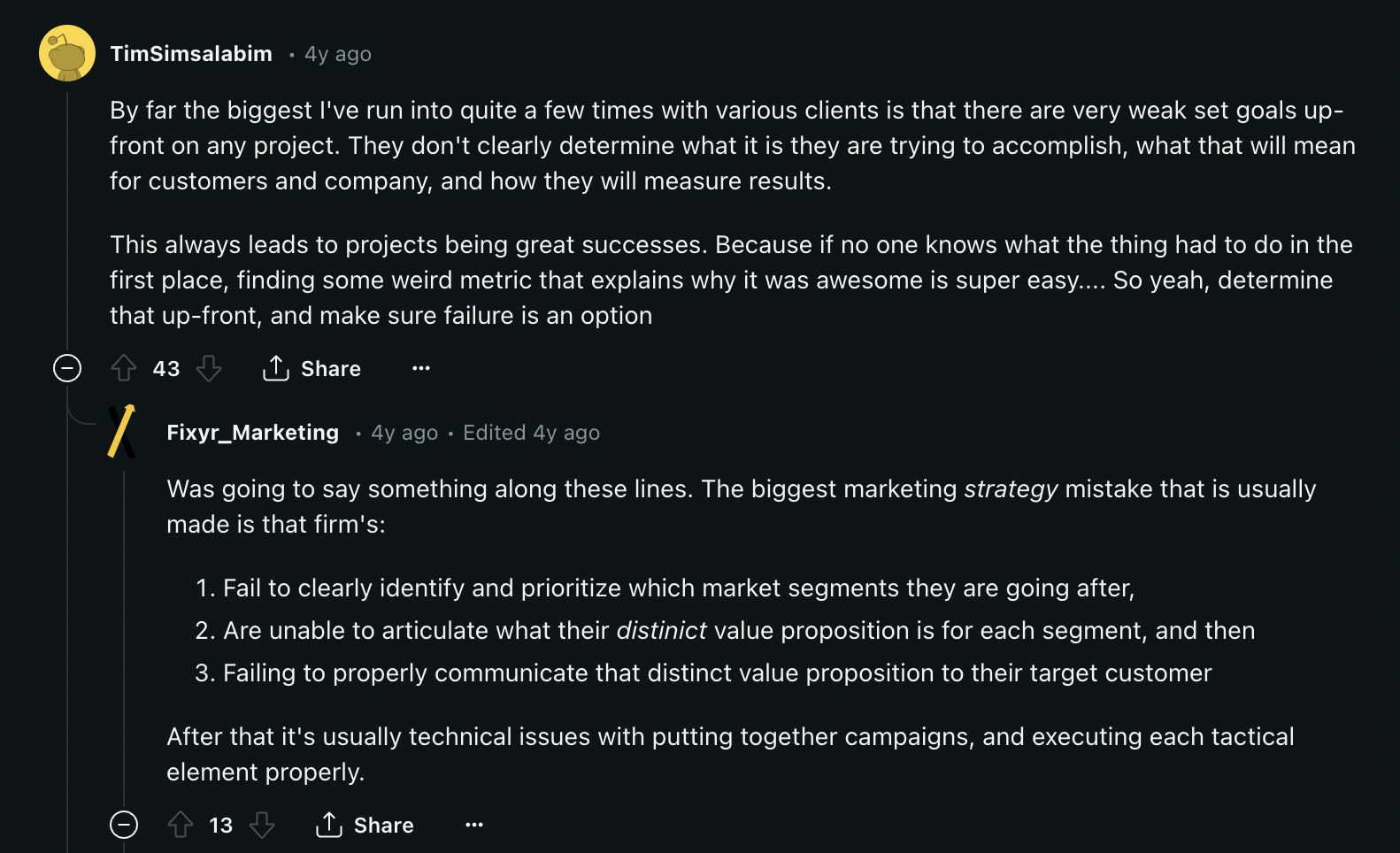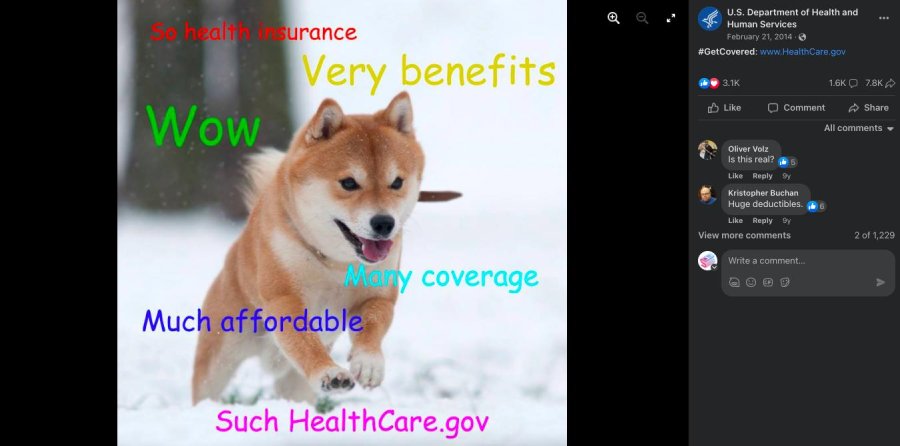
Working with many different marketing teams, interviewing countless candidates, and navigating through a myriad of strategies of our own clients to help them improve their marketing results, we’ve discovered that even the most experienced marketers can stumble upon easily overlooked pitfalls.
Here’s a look at some of the most commonly overlooked marketing mistakes that can turn your marketing from ‘oh yeah’ to ‘oh no’ 😱
Table of Contents
Mistake 1: Not Answering ‘What’s in This For Me?’
One of the most fundamental mistakes marketers can make (and I’ve seen this one all over the place) is forgetting to address the most important question a potential customer will have: ‘What’s in this for me?’.
I get it, it’s easy to get caught up in the excitement of your brand’s features or the accolades you’ve received. But, if your marketing messages are too focused on how great your product is without clearly articulating the benefits it offers, you risk losing your audience’s attention.
The Fix
To avoid this mistake, you need to put yourself in your audience’s shoes. Focus on how your product or service will solve their problems, make their lives easier, or add value. For example:
- Use customer-centric language: Frame your messaging around “you” and “your,” addressing the customer directly and making it clear how your product benefits them.
- Highlight benefits, not just features: While features describe what your product does, benefits describe what it does for the customer. Make sure you’re emphasizing how those features will improve the customer’s life or business.
- Show, don’t tell: Use customer testimonials, case studies, and real-world examples to illustrate how your product or service has helped others. This makes it easier for potential customers to envision the benefits for themselves.
- Focus on pain points: Identify the problems your audience is facing and position your product as the solution. People are more motivated to take action when they see a clear benefit in doing so.
Mistake 2: Assuming Everyone’s Just Like You
We all have a tendency to think everyone else sees the world as we do or share the same values and desires. But guess what? They don’t.
When you craft marketing messages based on your own experiences or preferences, you risk alienating large segments of your target audience. This often leads to ineffective campaigns that fail to resonate because they don’t align with what potential customers actually want or need.

For example, let’s say you love detailed technical specifications, so you fill your product descriptions with complex jargon and data. While this might appeal to a small subset of tech enthusiasts, you could be turning away potential customers who just want to know what the product does and how it benefits them.
The Fix
To avoid this mistake, you need to invest time and effort into truly understanding your audience.
- Do your research: Start with solid market research to identify your target audience and their preferences. Use surveys, interviews, and focus groups to gather insights into what they value and how they think.
- Create customer personas: Develop detailed customer personas with Pathmonk Intelligence that represent your different audience segments. These personas should include demographics, interests, pain points, and buying behaviors, helping you tailor your messaging to each group. If you need some help, you can use our free customer persona template.
- Test and iterate: Don’t assume you’ve nailed it on the first try. Test different messages, formats, and channels to see what resonates most with your audience. Use A/B testing and other feedback mechanisms to refine your approach based on actual data.
Mistake 3: The ‘One-Size-Fits-All’ Campaign
You wouldn’t wear a onesie to a business meeting (hopefully), so why treat your marketing that way?
When you push the same content across all your marketing channels, you miss the opportunity to connect with your audience in ways that are relevant and tailored to each platform. For example, what works on Instagram might not work on LinkedIn, and a message that’s effective for tech-savvy millennials might fall flat with older professionals. By ignoring these nuances, you risk coming across as tone-deaf or irrelevant.
The Fix
To avoid this pitfall, you need to customize your marketing strategy for each channel and audience. Extra work, sure, but extra rewards too:
- Know your channels: Each marketing channel has its own unique audience, tone, and best practices. Learn what works best on each platform. For instance, Instagram is great for visual storytelling, while LinkedIn is more suited for professional insights and industry news.
- Segment your audience: Remember mistake number 2? Break down your audience into distinct groups based on demographics, interests, and behaviors. This allows you to create targeted messages that resonate with each segment, rather than trying to appeal to everyone with a single, generic message.
- Tailor your content: Customize your content for each channel and audience segment. This means creating different versions of your message to fit the style, format, and expectations of each platform. For example, you might use a catchy video for TikTok and a detailed article for your blog.
Mistake 4: Set It And Forget It
Ah, the dream of automation: set it, forget it, and watch the leads roll in!
Many businesses fall into the trap of setting up automated marketing campaigns and then moving on to the next big thing. The result? They miss out on optimization opportunities, let errors slide, and fail to respond to changes in the market or their audience’s needs. Automated emails go out with outdated offers, scheduled social media posts miss critical context, and marketing performance stagnates due to lack of monitoring.
A marketer’s worst nightmare come true if you ask me.
The Fix
To avoid the ‘Set it and forget it’ mistake, you need to actively manage and optimize your automated campaigns.
- Regularly review and update content: Automated campaigns should not be treated as something that you did once and that’s it. Regularly review your automated content to ensure it’s up-to-date and relevant.
- Check your automations are working correctly: Automation tools are great, but they aren’t perfect. Regularly check to ensure your automations are functioning as intended. This includes testing triggers, ensuring sequences are firing correctly, and confirming that personalized elements (like customer names or specific product details) are displaying properly.
Mistake 5: Data? What Data?
Ignoring data is like driving with your eyes closed. Yet, it’s *unbelievable* the amount of marketers that either don’t care about or don’t know about tracking results and they just dismiss data. The fact is, without proper data tracking and analysis, you’re essentially navigating your marketing strategy based on guesswork rather than informed decisions.

The Fix
To avoid this recurring and particularly painful mistake, you need to incorporate data-driven decision-making into your marketing strategy.
- Set clear goals and metrics: Before launching any marketing plan or campaign, establish clear goals and the metrics you’ll use to measure success. Whether it’s increasing website traffic, boosting sales, or growing your social media following, having defined objectives helps you focus on what’s important. Learn more about the key metrics that you should be tracking as a marketer.
- Share these goals with your team: Make sure everyone involved in the campaign understands the objectives and the metrics that matter. This is vital, as it ensures that your team is aligned and working towards the same goals. It also helps to foster accountability and a results-driven culture.
- Regularly collect and analyze data: Use Pathmonk Intelligence to collect data on your campaigns, audience behavior, and performance metrics. Regularly analyze this data to identify trends, understand what’s working, and pinpoint areas for improvement.
- Make data-driven decisions: Use the insights gained from your data analysis to inform your marketing decisions. Whether it’s adjusting your messaging, targeting a different audience, or reallocating your budget, base your actions on evidence rather than assumptions.
Mistake 6: Ignoring the Customer Journey
When you treat your marketing efforts as isolated touchpoints rather than interconnected stages of the customer journey, you risk creating a disjointed experience that confuses or alienates potential customers.
This fragmented approach often leads to inconsistent messaging, missed opportunities, and a lack of understanding of how customers move from awareness to consideration to decision. Definitely one of the worst marketing mistakes you can make.
The Fix
To avoid ignoring the customer journey, you need to adopt a holistic approach to your marketing strategy. Here’s how:
- Map your customer journey: Start by mapping out the typical customer journey for your product or service. Identify the key stages, from awareness to consideration to decision, and understand the touchpoints where customers interact with your brand. If you need an extra hand, download our free Customer Journey Strategy.
- Personalize your prospective customers’ interactions: Personalization is key to enhancing the customer journey. Use Pathmonk Accelerate to deliver relevant experiences and offers that align with each customer’s interests and stage in the journey. This personalized approach improves engagement and helps build a stronger connection with your brand, increasing +50% conversions on average. If you want to preview how this would work on your website, try our free interactive demo.
Increase +180%
leads
demos
sales
bookings
from your website with AI
Get more conversions from your existing website traffic delivering personalized experiences.

Mistake 7: One Landing Page to Rule Them All
Assuming that a single landing page can effectively cater to all of your marketing needs is a major mistake that many marketers make, especially in early stages or when they are running short on resources.

This can result in a cluttered, confusing user experience that fails to address the specific needs and expectations of different audience segments, because when your landing page tries to be all things to all people, it often ends up being relevant to no one, leading to low conversion rates and lost opportunities.
The Fix
- Tailor your pages to your audience: Create unique landing pages for different audience segments or personas. This allows you to tailor the content and messaging to the specific needs and interests of each group, increasing relevance and engagement.
- Keep it simple: Avoid overwhelming your audience with too much information or too many choices. Keep your landing pages focused on a single, clear objective or call to action. This streamlined approach makes it easier for visitors to understand what you want them to do next and increases the likelihood of conversion.
- Use AI to hyper-personalize your landing pages: Listen, if you don’t have the time or resources to create tailored landing pages, you can still save the day by implementing Pathmonk Accelerate, which will craft personalized interactions to your website visitors and boost engagement and conversions.
Mistake 8: Social Media Overload
Sure, social media is important, but do you really need to be on every platform? In the quest for a broad online presence, many marketers make the mistake of spreading themselves too thin across too many social media channels. The result? An overload of platforms to manage and a lack of focus on what really matters.

The Fix
To avoid social media overload, you need to prioritize and focus on the platforms that align with your business goals and audience.
- Identify your core platforms: Start by identifying the key social media platforms that align with your business and target audience. Focus on the channels where your audience is most active and where you can deliver the greatest impact. For example, if you’re targeting professionals, LinkedIn might be a better focus than TikTok.
- Create a platform-specific strategy: Each platform has its own unique audience and best practices, so it’s important to develop a tailored strategy for each one you choose to focus on. Understand the tone, content, and engagement style that works best for each platform and align your efforts accordingly.
- Prioritize quality over quantity: It’s better to have a strong presence on a few key platforms than a weak presence on many. Focus on creating high-quality, relevant content for your chosen platforms rather than trying to cover every single one. Consistency and quality are key to building a strong social media presence.
Mistake 9: Hoping One Social Media Post Will Go Viral
In the age of viral sensations and trending hashtags, it’s easy to dream of crafting that one perfect post that will take the internet by storm. However, banking on a single social media post going viral is like hoping to win the lottery as a business strategy—it’s unrealistic and unreliable. Relying on a viral hit to achieve your marketing goals is a common, yet flawed, approach that will lead to disappointment and missed opportunities.
This approach also ignores the long-term strategy needed to build a strong brand presence, engage with your audience, and achieve sustainable growth.
The Fix
- Focus on a long-term consistent strategy: Instead of hoping for a viral post, focus on creating high-quality, relevant content that resonates with your audience. Consistent, valuable content is the foundation of a strong social media presence and is more likely to attract and retain followers over time.
- Engage with your audience: Build a relationship with your audience by engaging with them regularly. Respond to comments, participate in conversations, and show genuine interest in your followers. This engagement builds loyalty and encourages sharing, which is more effective for organic growth than chasing virality.
- Create shareable content: While viral success can’t be guaranteed, you can increase your chances by creating shareable content. This means focusing on topics that resonate with your audience, using engaging visuals, and crafting compelling headlines or captions. Shareable content encourages organic growth through word-of-mouth.
Mistake 10: Failing to Align Marketing and Sales
One of the most critical but often overlooked marketing mistakes is the disconnect between marketing and sales teams. When marketing and sales operate in silos, it leads to a breakdown in communication and a lack of shared goals. Marketing may be focused on generating a high volume of leads, while sales may be struggling to convert those leads into customers.
This disconnect often results in wasted resources, missed opportunities, and friction between the two departments. The lack of alignment can also lead to a poor customer experience, as potential clients receive inconsistent messages or fall through the cracks during the handoff from marketing to sales.
This lack of alignment between marketing and sales is like having a beautifully designed car without a driver—it’s not going to get you where you need to go.
The Fix
To avoid this common challenge, you need to create a strong alignment between marketing and sales teams.
- Establish shared goals: I’ve mentioned this one before, but just as important as having the entire marketing team aligned is coordinating both marketing and sales. Create unified goals that align with overall business objectives. Both teams should focus on metrics like revenue, customer acquisition, or conversion rates, ensuring that everyone is working toward the same outcomes.
- Foster open communication: Encourage regular communication and collaboration between marketing and sales. This can be achieved through joint meetings, shared reporting, and open channels of communication, ensuring that both teams are on the same page.
- Define the lead handoff: Clearly define the process for handing off leads from marketing to sales. This includes establishing criteria for what constitutes a qualified lead, as well as setting expectations for follow-up and nurturing.
Mistake 11: Content Vomiting Without an Actual Strategy and Keyword Research
In the age of Chat GPT many businesses fall into the trap of churning out volumes of content without a clear strategy or understanding of what their audience is actually searching for.
This approach leads to a number of issues: first, it wastes time and resources on content that doesn’t align with business goals or attract the right audience. Second, it clutters the website or blog with irrelevant or redundant material, which can confuse or alienate potential customers. Finally, it misses out on the opportunity to rank for valuable search terms, reducing organic traffic and visibility.
The Fix
To avoid this mistake, you need to develop a focused content marketing plan that’s aligned with your audience’s needs and business objectives. Here’s how:
- Define your content goals: Goals, goals, goals. But yes, first thing is to identify what you want to achieve with your content. This might include increasing brand awareness, driving traffic, generating leads, or establishing thought leadership. Having clear goals helps you focus your efforts and measure success.
- Understand your audience: Remember we’ve also covered this before. Brainstorm content ideas that match your customer personas’ needs, interests, and challenges. This customer-centric approach ensures your content is relevant and engaging.
- Conduct keyword research: Use research tools to identify the search terms your audience is using. Focus on keywords that align with your business goals and have a balance of search volume and competition. Incorporate these keywords naturally into your content to improve search engine rankings.
- Develop a content strategy: Create a content plan that outlines the types of content you’ll create, the topics you’ll cover, and the platforms you’ll use to distribute it. This strategy should align with your goals, audience, and keyword research, providing a roadmap for your content marketing efforts.
- Create high-quality content: Focus on creating valuable, high-quality content that addresses your audience’s needs and aligns with your strategy. This might include blog posts, videos, infographics, or other formats that resonate with your target audience.
- Promote and measure: Promote your content through appropriate channels, such as social media, email marketing, or paid advertising. Monitor the performance of your content and use Pathmonk Intelligence to measure its impact on your goals. Adjust your strategy based on the results to continually improve.
Mistake 12: Doing What Your Competitors Are Doing
Yes, it’s tempting to mimic the strategies of your competitors, especially when they seem to be achieving success.
However, blindly following what others are doing can lead to missed opportunities and diluted brand identity. This ‘me-too’ approach fails to recognize the unique strengths and needs of your business, makes it harder to stand out from the crowd, and also risks leading you down the wrong path if your competitors’ strategies are not aligned with your business goals or customer needs. Additionally, this approach can result in a reactive rather than proactive marketing strategy, where you’re constantly chasing trends instead of setting them.
The Fix
Create a marketing strategy that’s uniquely tailored to your brand, audience, and goals:
- Define your unique value proposition: Start by clearly defining what sets your brand apart from the competition. Your unique value proposition (UVP) should highlight the specific benefits and advantages your product or service offers, differentiating you from others in the market.
- Develop a unique brand identity: Create a distinctive brand identity that reflects your UVP and resonates with your audience. This includes your brand’s voice, visual identity, and messaging, all of which should be unique to your business and consistent across all marketing channels.
- Innovate and experiment: Rather than mimicking your competitors, focus on innovation and experimentation. Try new marketing tactics, explore emerging channels, and test different approaches to see what works best for your business. This proactive approach helps you stay ahead of the curve and set trends rather than following them.
- ‘Good artists copy, great artists get inspired’: While it’s important to monitor what your competitors are doing, use this information as inspiration rather than a blueprint. Learn from their successes and mistakes, but always filter their strategies through the lens of your own business goals and audience needs.
Mistake 13: Believing One Intern Can Take Over Your Marketing Strategy
Raise your hand if you started your marketing career as a one-person orchestra.
It’s a familiar scene: a business brings in a promising intern and expects them to manage the entire marketing strategy. While junior talent can be a great asset, placing the weight of your marketing on the shoulders of someone whit little experience is a major mistake that can lead to ineffective campaigns and missed opportunities.
The Fix
It may seem obvious, but to avoid one of the most dangerous marketing mistakes you need to:
- Take your marketing seriously: Start by creating a comprehensive marketing strategy that aligns with your business goals. This plan should outline your target audience, key messaging, marketing channels, and specific objectives. Having a clear strategy ensures that your marketing efforts are focused and effective.
- Grow an experienced marketing team: Ensure that your marketing efforts are led by experienced professionals who understand your business and industry. These individuals can provide strategic direction, oversee campaign execution, and mentor less experienced team members, including interns.
- Provide structured internships: Entry positions should be a learning experience, not an overwhelming responsibility. Provide interns with structured roles and tasks that allow them to gain valuable skills and contribute to your marketing efforts without being solely responsible for strategy or key campaigns.
Mistake 14: Expecting Results Without a Budget
Many businesses dream of marketing success but falter when it comes to allocating the necessary resources to achieve it. Expecting great marketing results without a budget is like trying to cook a gourmet meal with only a few ingredients—you might end up with something edible, but it won’t be impressive.
Without a proper budget, marketing efforts are often constrained and ineffective. Businesses might cut corners on important aspects like advertising, content creation, or marketing tools, leading to campaigns that fail to reach their full potential. Additionally, without a clear budget, it’s challenging to set realistic goals, measure return on investment (ROI), or scale successful strategies.
This lack of investment and planning often leads to frustration when marketing doesn’t deliver the desired results.
The Fix
- Understand the resources needed: Start by defining what you want to achieve with your marketing. Whether it’s increasing brand awareness, generating leads, or boosting sales, having clear goals helps you understand what resources you’ll need to achieve them.
- Allocate resources strategically: Prioritize your marketing activities based on their potential impact and alignment with your goals. Allocate your budget to the areas that will deliver the most value, focusing on high-impact strategies while avoiding unnecessary expenses.
- Monitor and adjust: Regularly review your marketing budget and adjust as needed. Monitor your spending, track your ROI, and be prepared to reallocate resources based on performance. This iterative approach ensures that your budget remains aligned with your goals and delivers maximum value.
- Invest in quality: Don’t skimp on important aspects of your marketing, such as content quality, creative design, or advertising spend. Investing in quality helps ensure that your marketing efforts are effective, engaging, and aligned with your brand.
Mistake 15: ‘Let’s Do Guerrilla Marketing’
I’m saving the best for last.
While not necessarily the most damaging mistake, it’s one of the most commonly misunderstood marketing strategies. Guerrilla marketing can indeed be creative, cost-effective, and attention-grabbing, but many people believe it’s a magic bullet that guarantees success with minimal investment. While it’s closely related to other mistakes already mentioned, the added fatal ingredient is that it usually comes from a person who believes that, just because you’re a marketer, you should know a few tricks to pull off this type of cool, cheap, and effective crazy marketing.

The main issue with jumping into guerrilla marketing without proper planning and understanding is that it often leads to wasted resources and disappointing results.
The Fix
To avoid falling into this trap, you need to carefully evaluate whether guerrilla marketing is the right fit for your brand and ensure you have the right approach to execute it effectively.
- Evaluate fit: Before jumping into guerrilla marketing, evaluate whether it’s the right strategy for your brand, audience, and goals. Guerrilla marketing works best for brands that have a bold, edgy image and are targeting audiences who appreciate unconventional approaches.
- Plan thoroughly: Guerrilla marketing requires careful planning and creativity. Develop a detailed plan that outlines your objectives, target audience, messaging, and execution strategy. Consider potential risks and how you will manage them to ensure a positive outcome.
- Have a more conventional marketing approach in parallel: While guerrilla marketing can be exciting and attention-grabbing, it should not be your sole marketing strategy. Maintain a more conventional marketing approach in parallel, utilizing proven tactics like content marketing, email campaigns, social media advertising, and search engine optimization to ensure consistent and reliable results.





